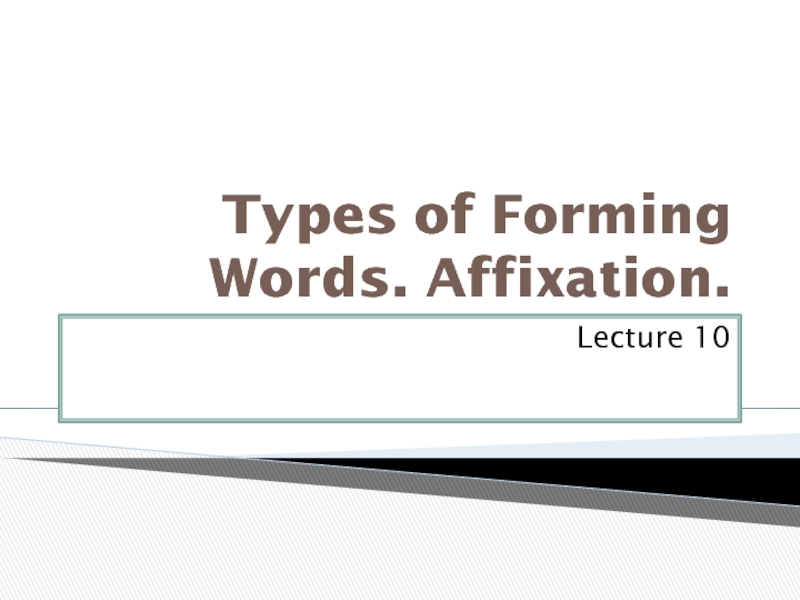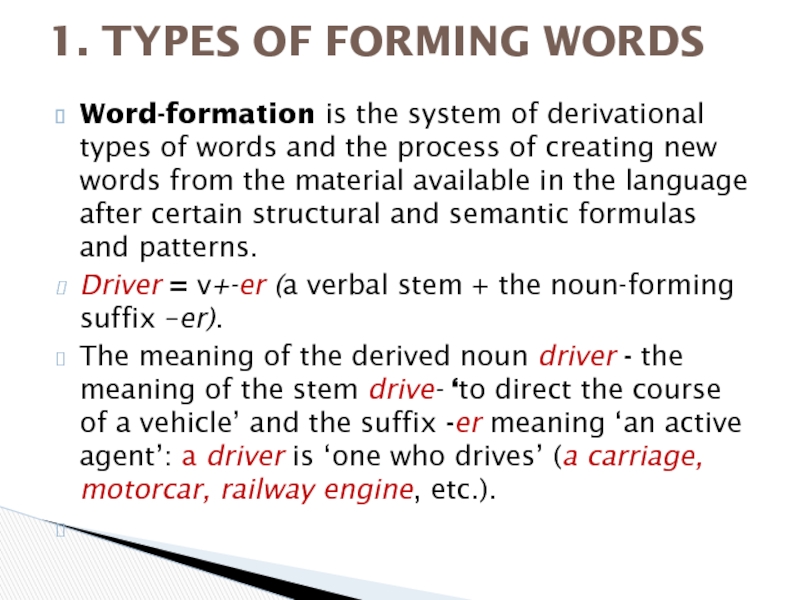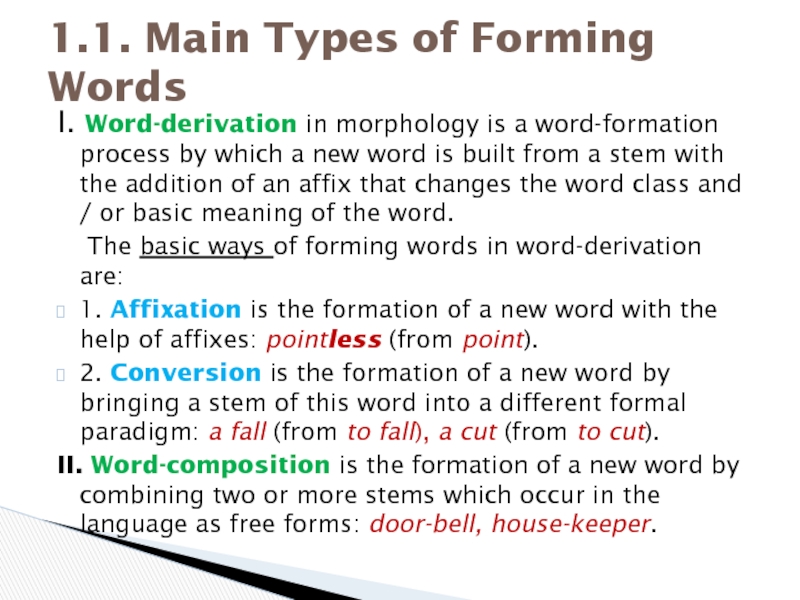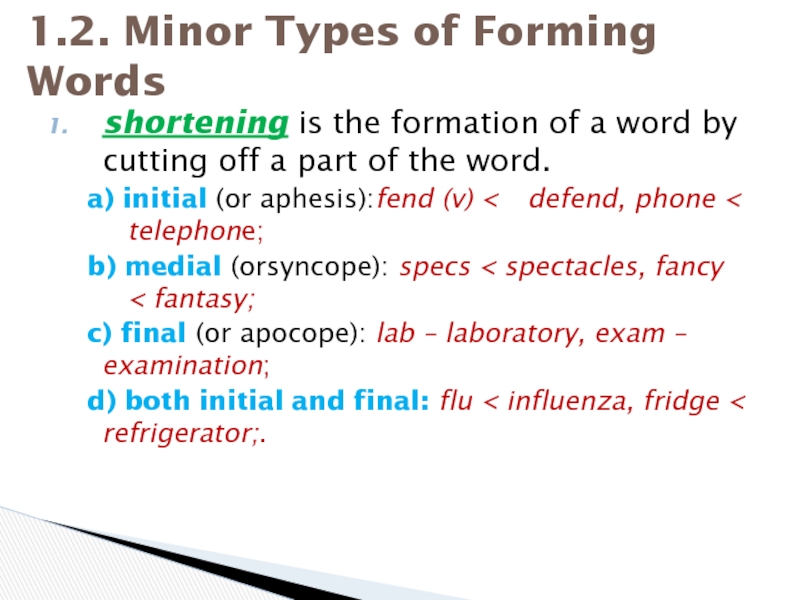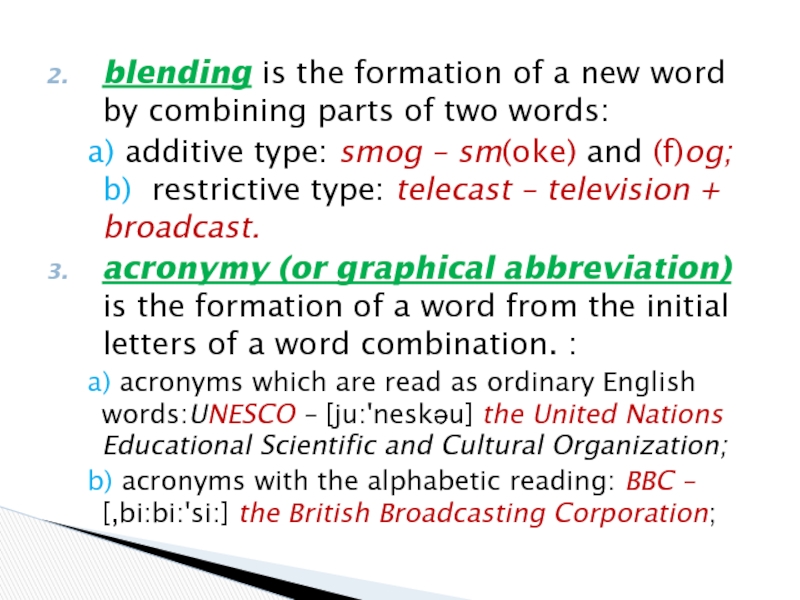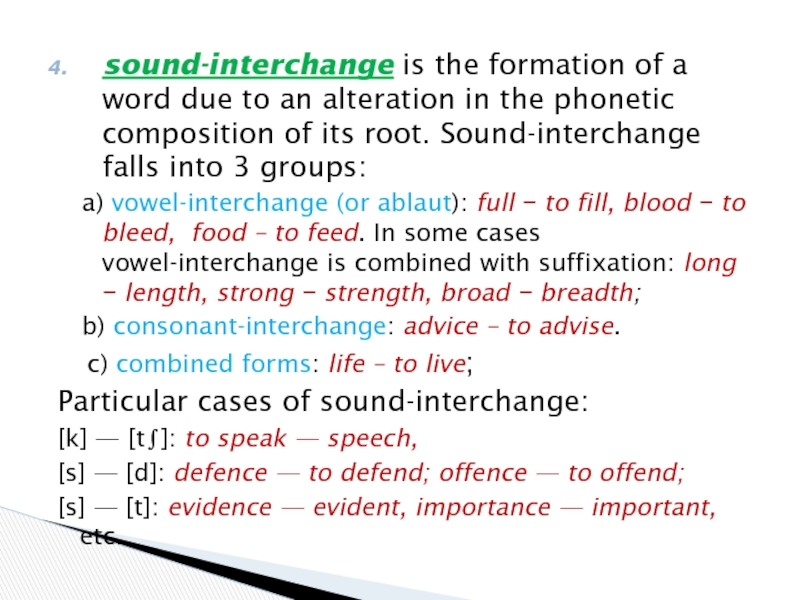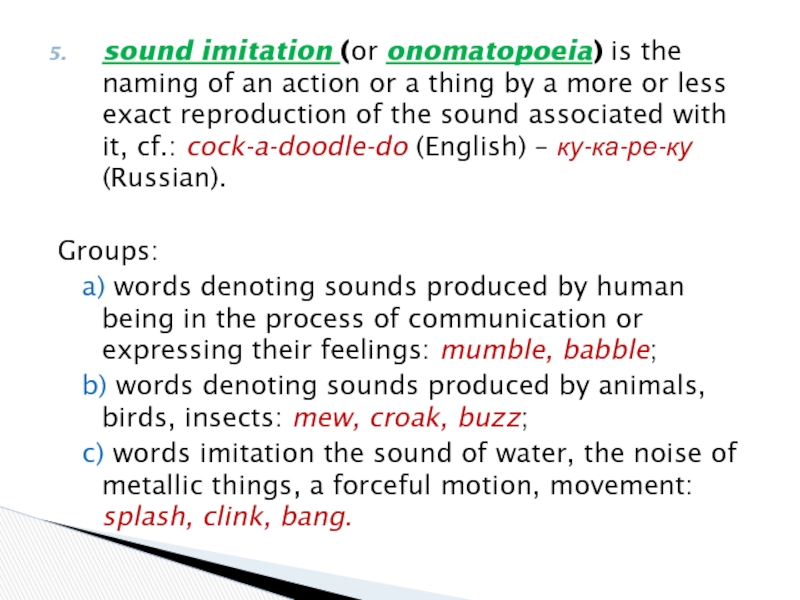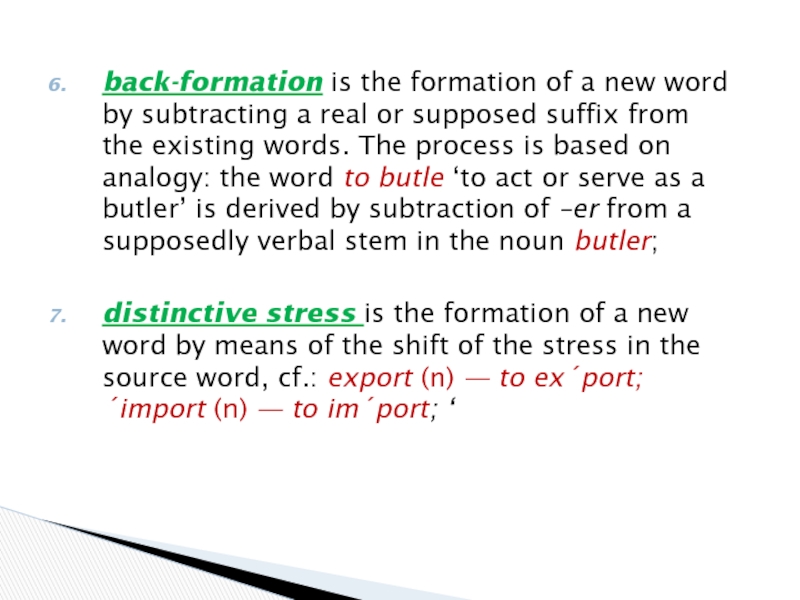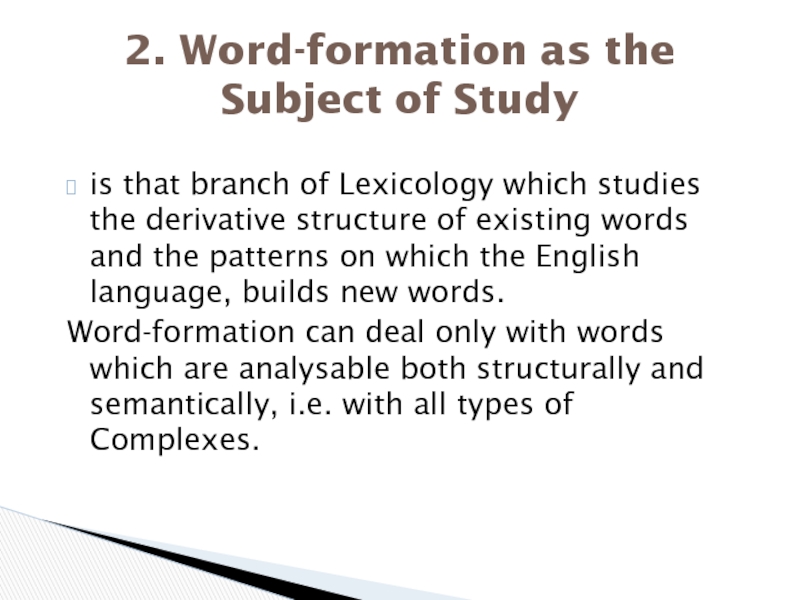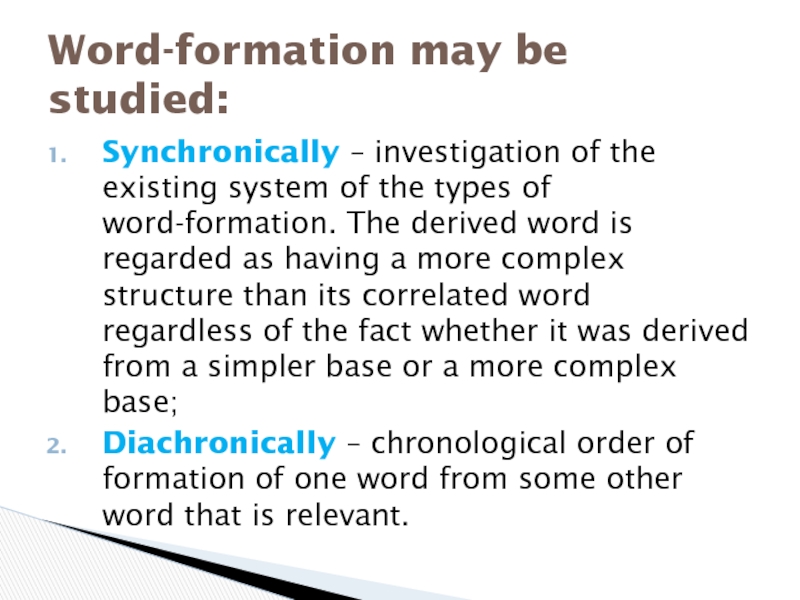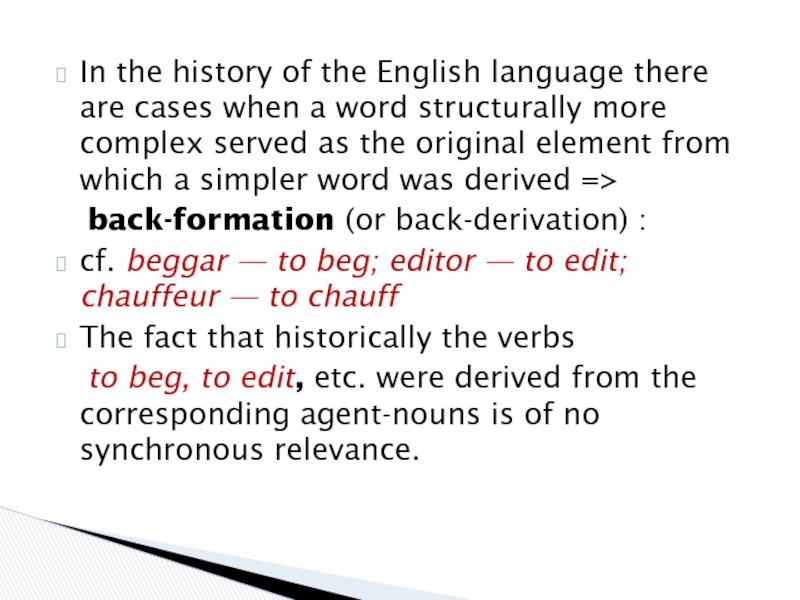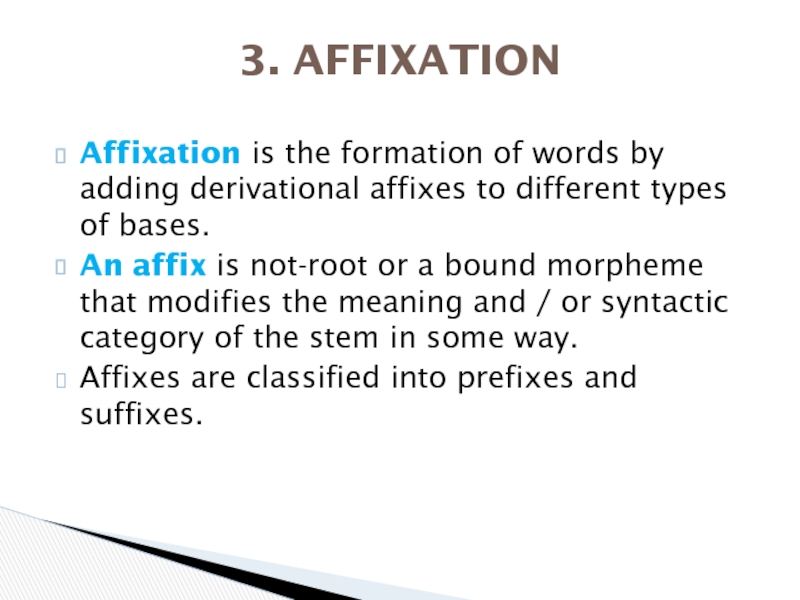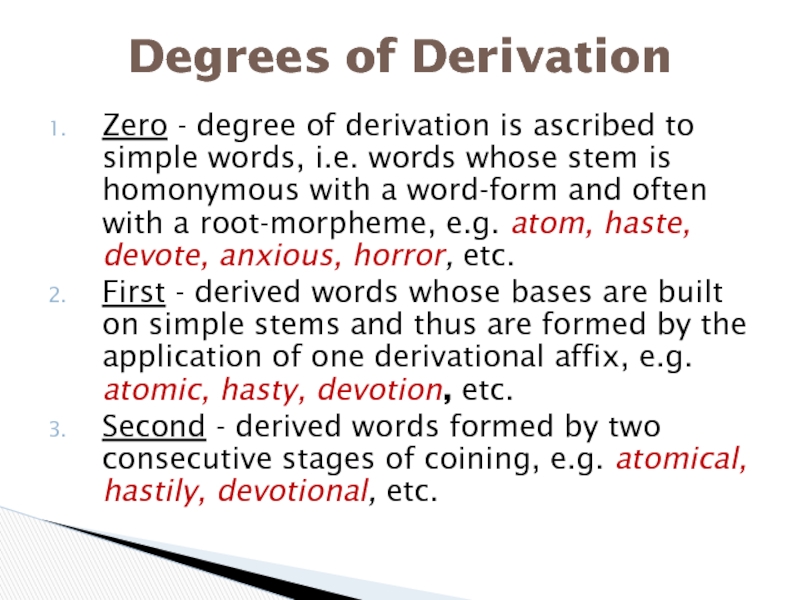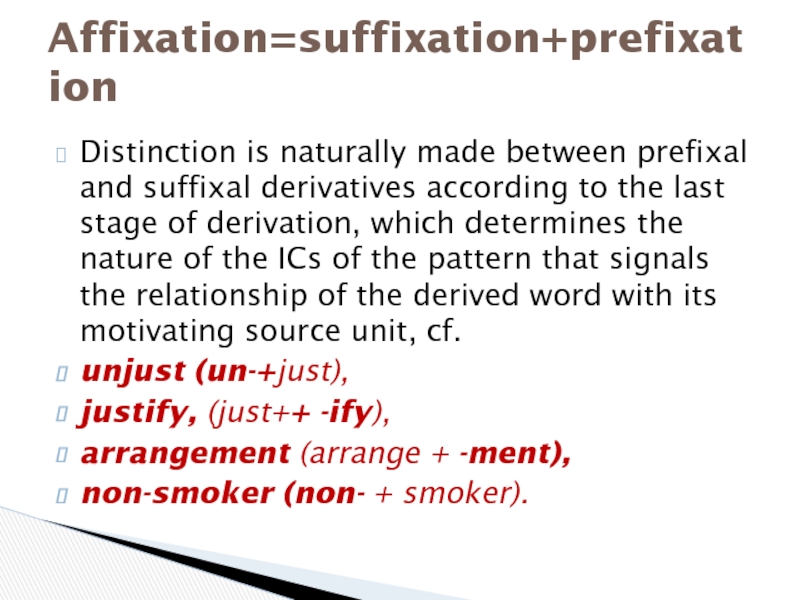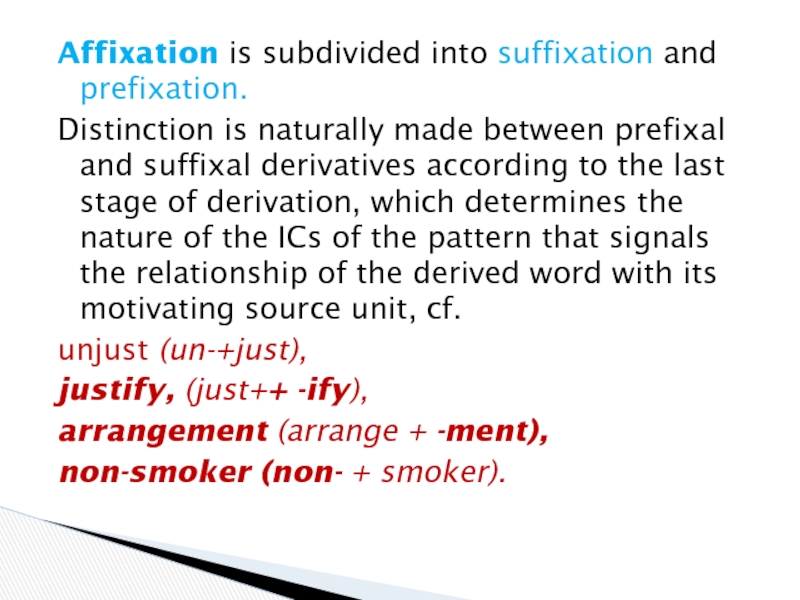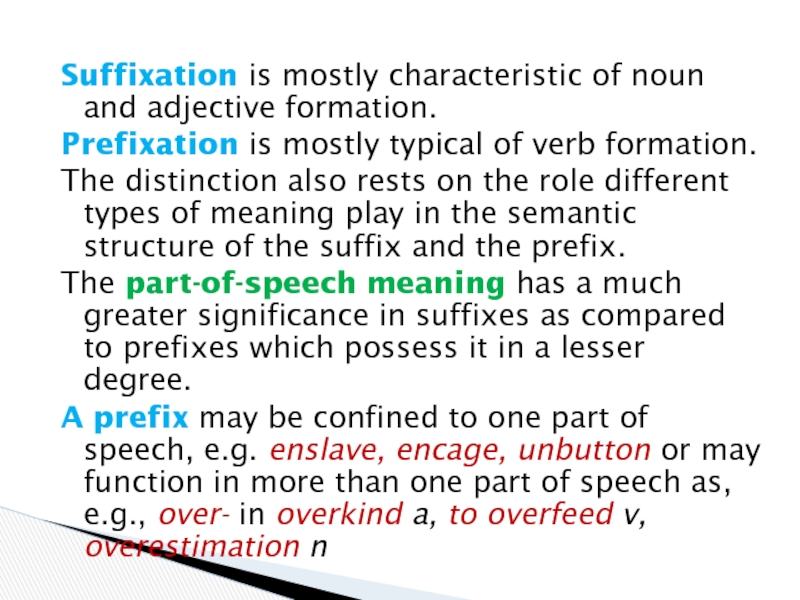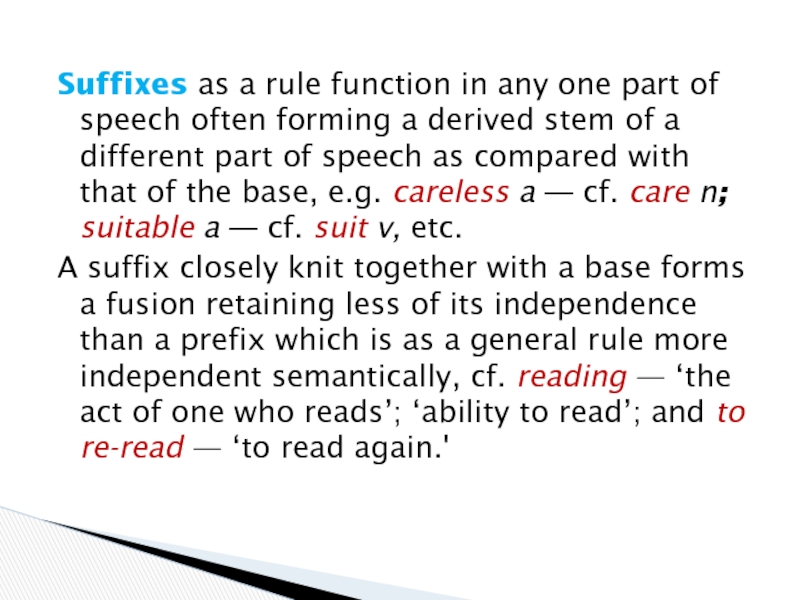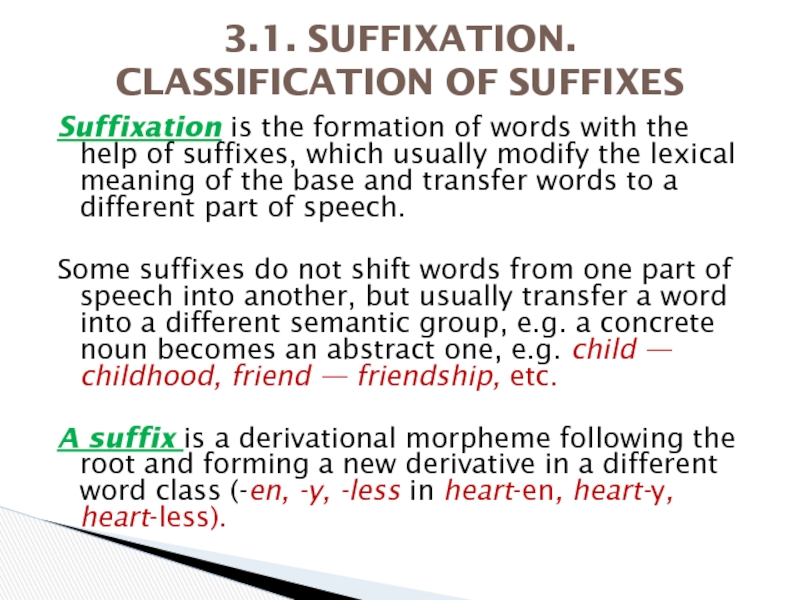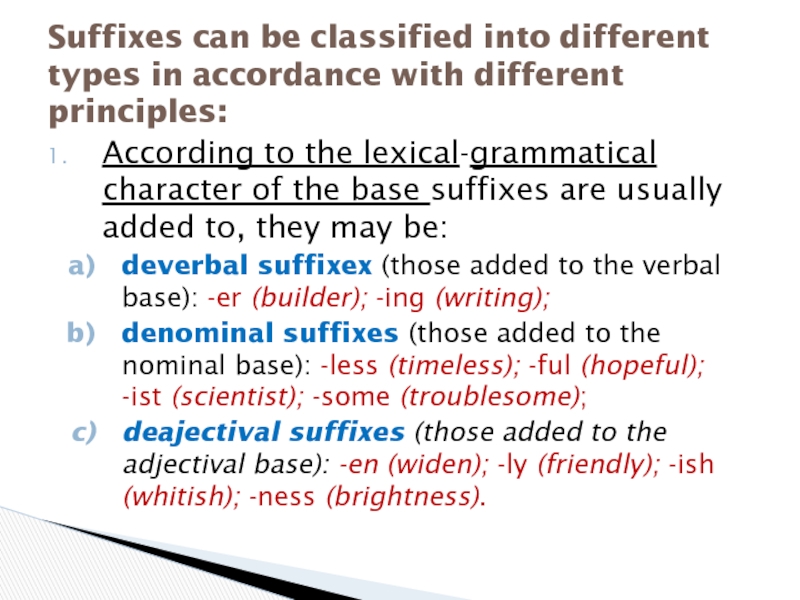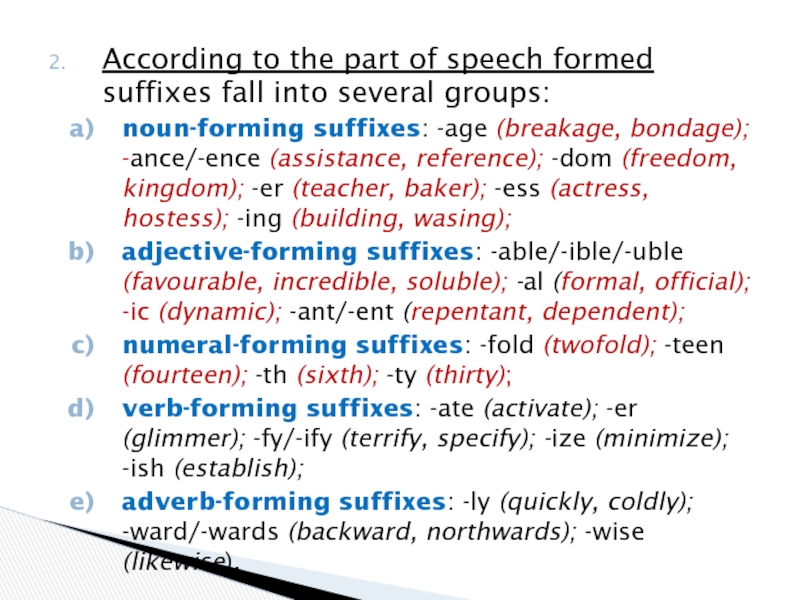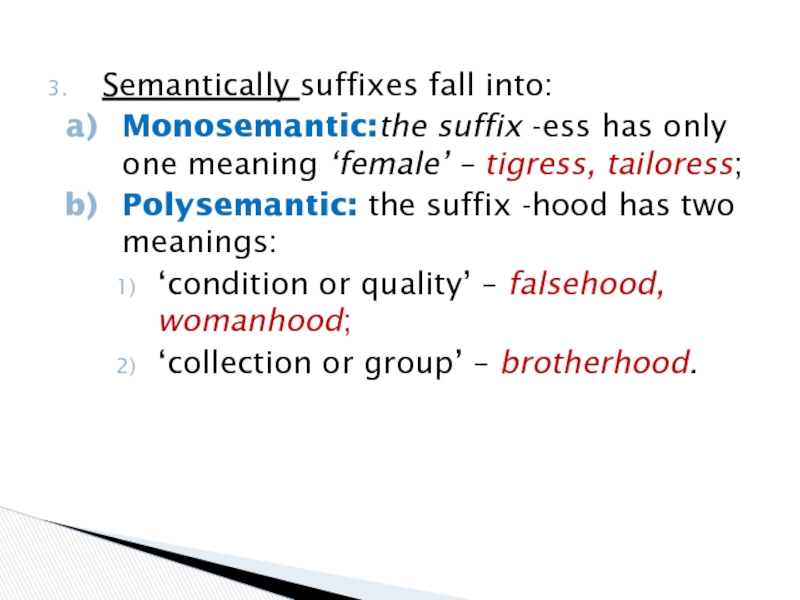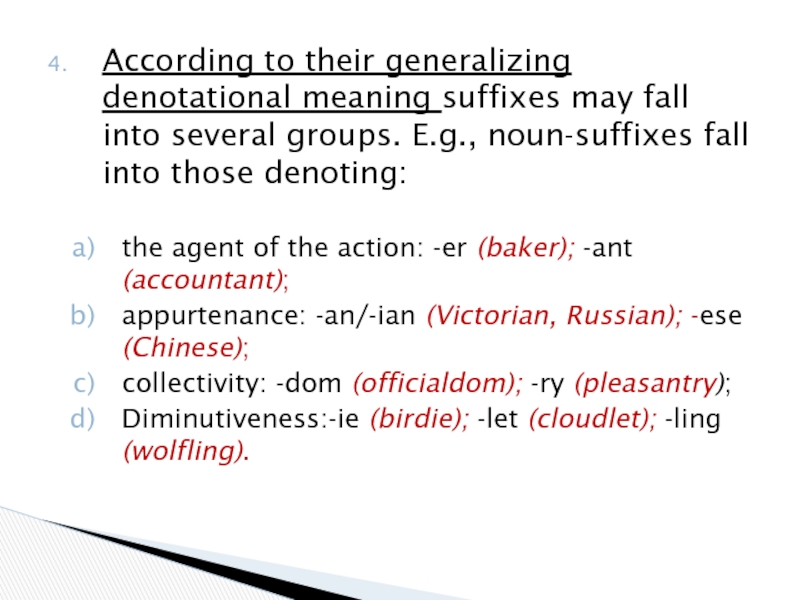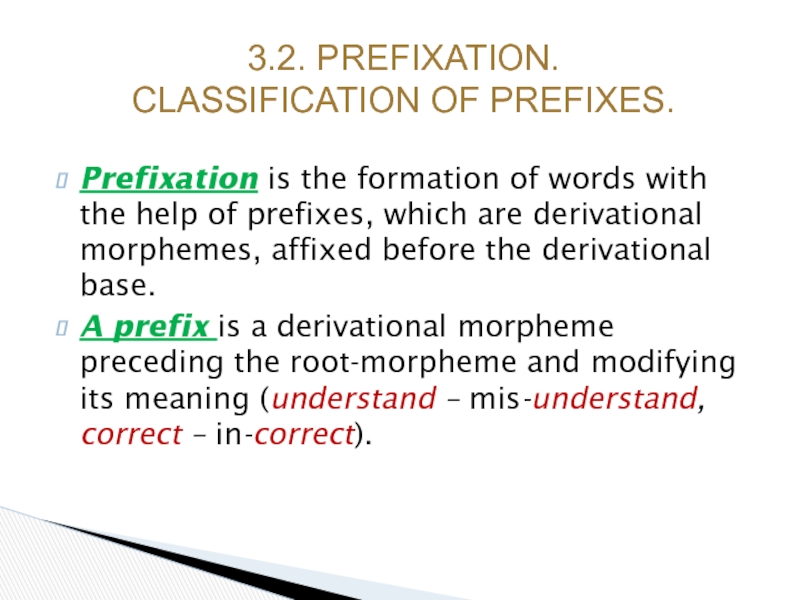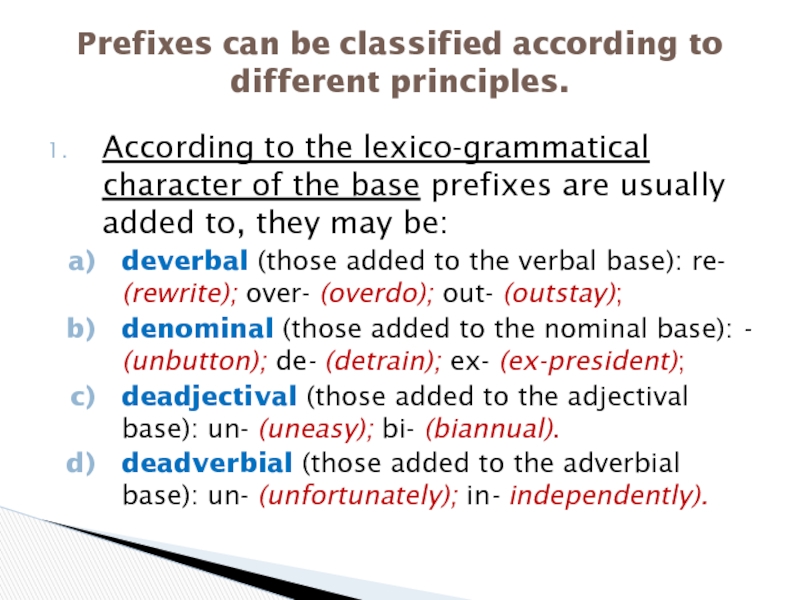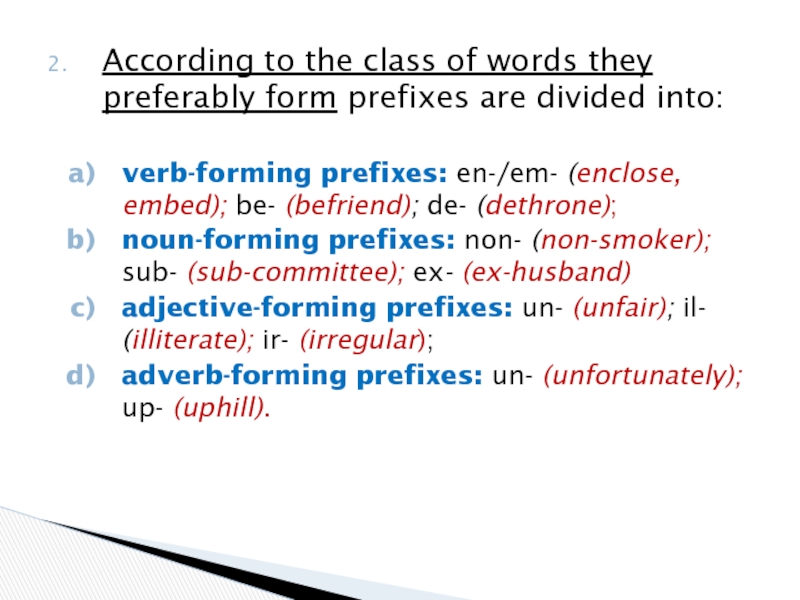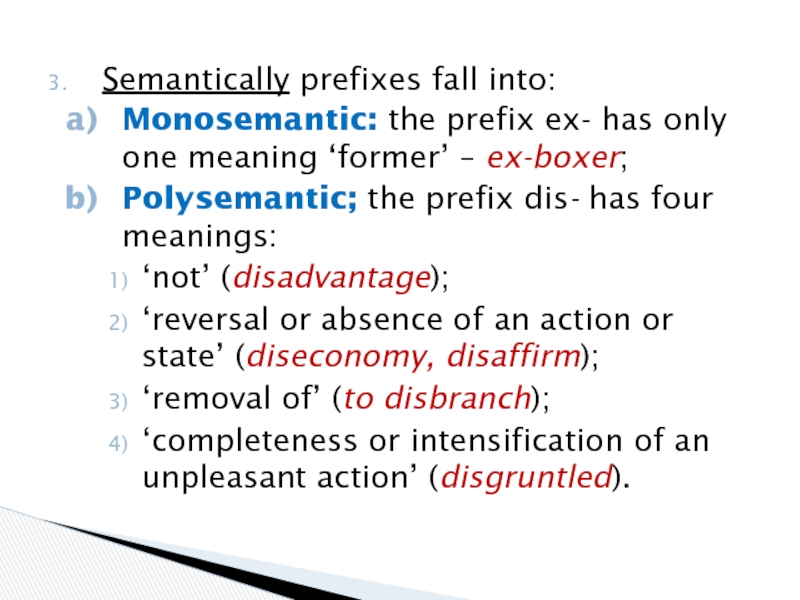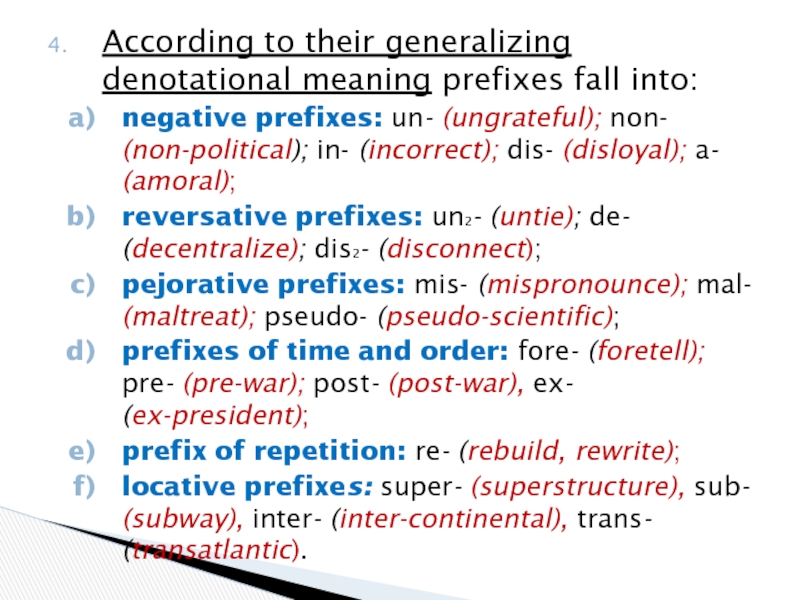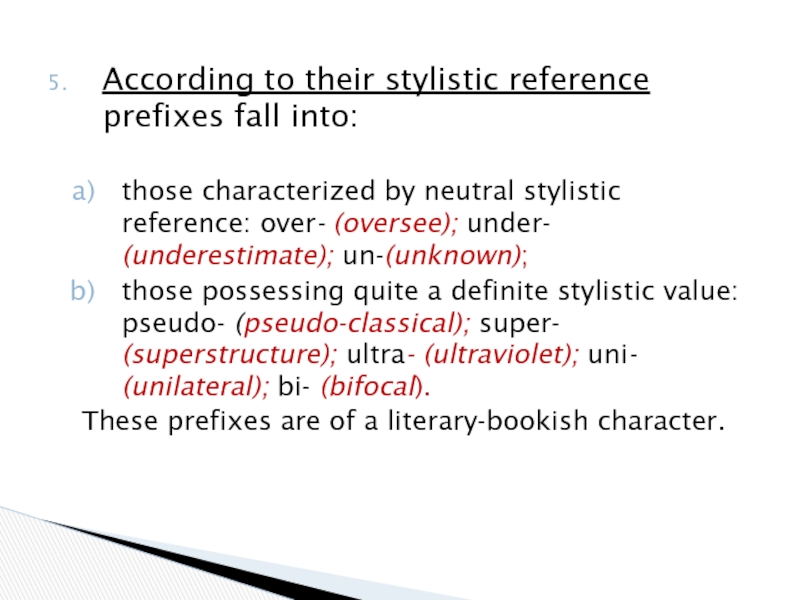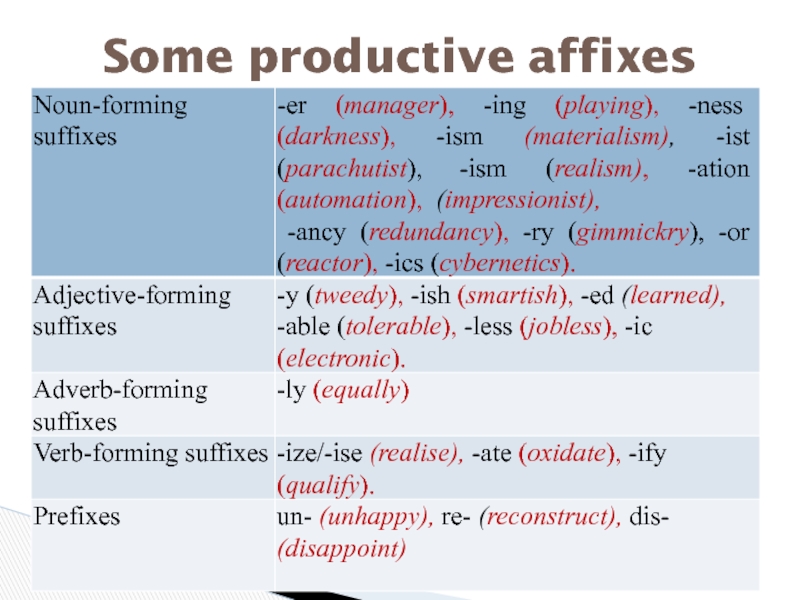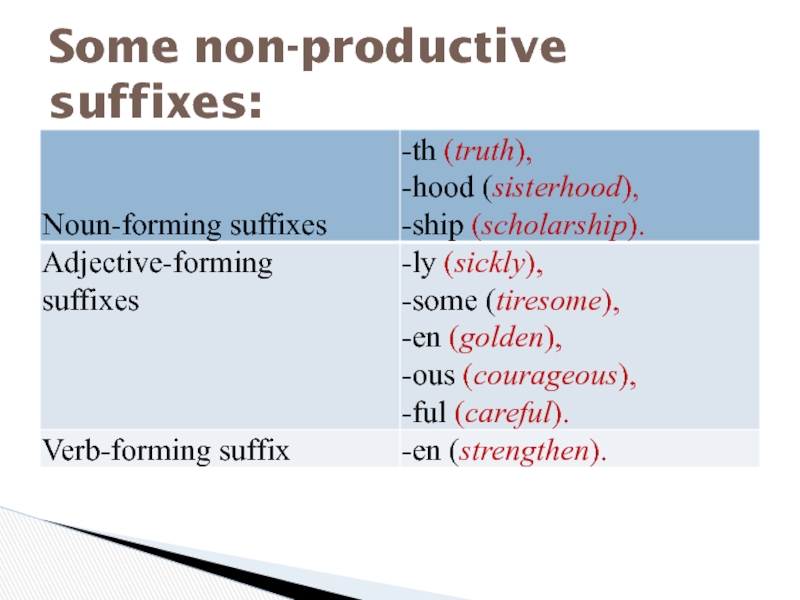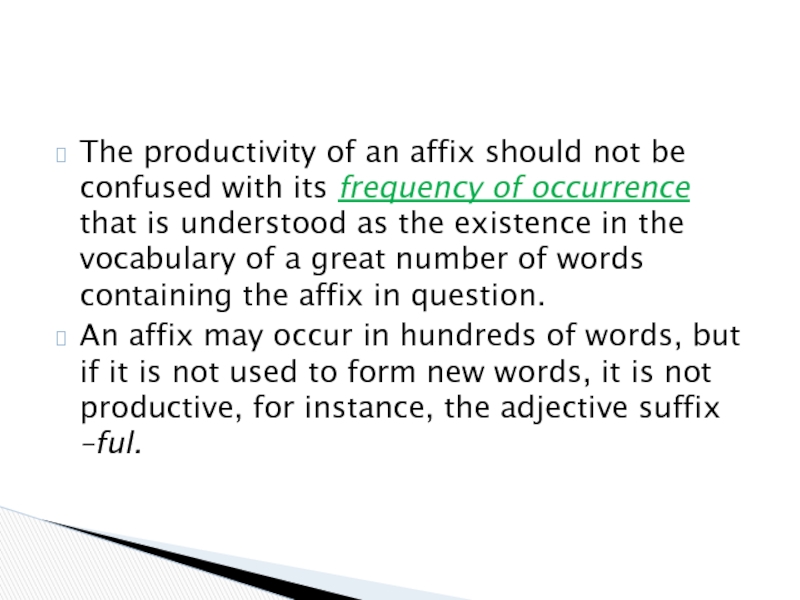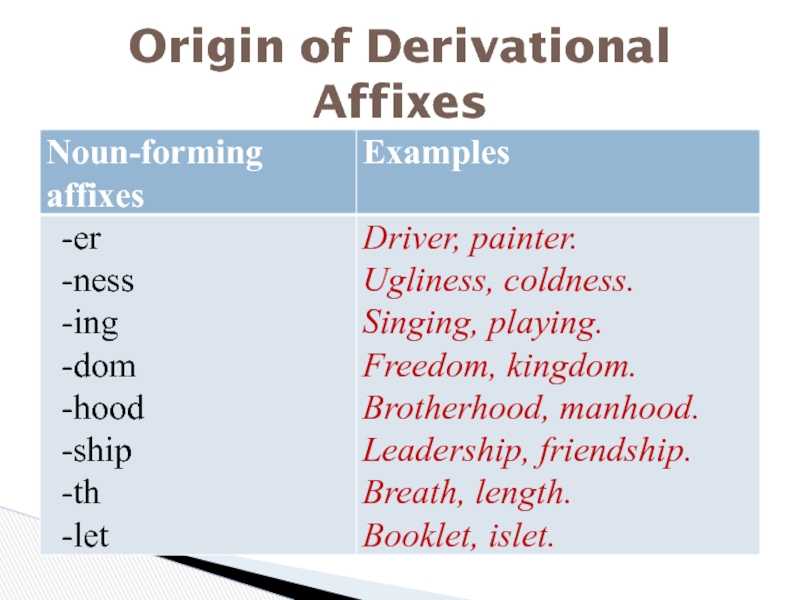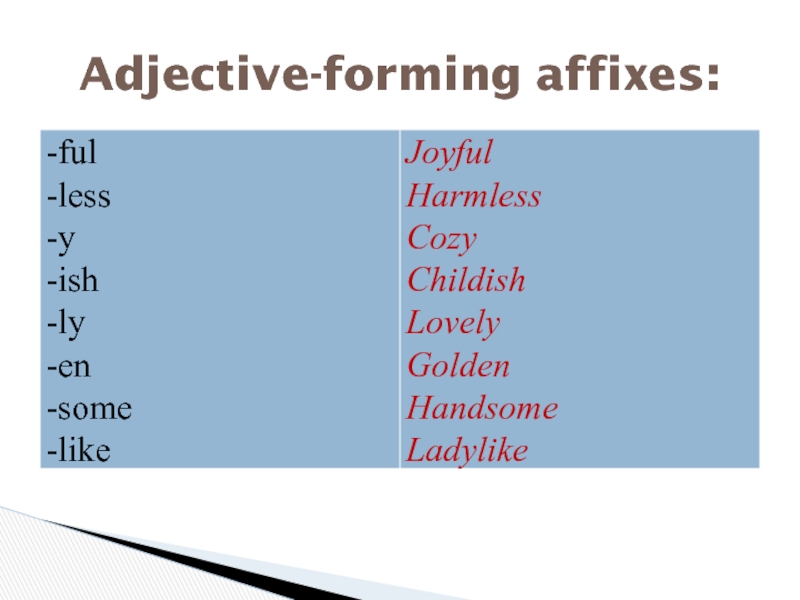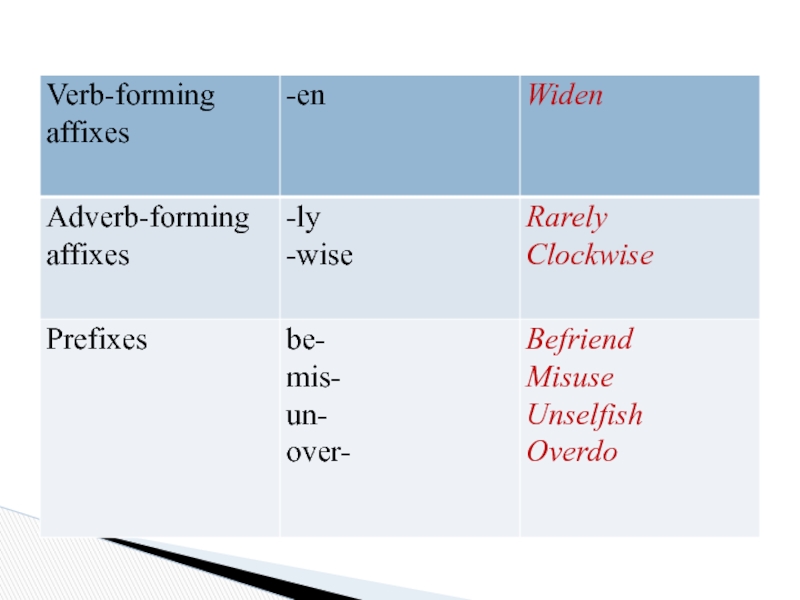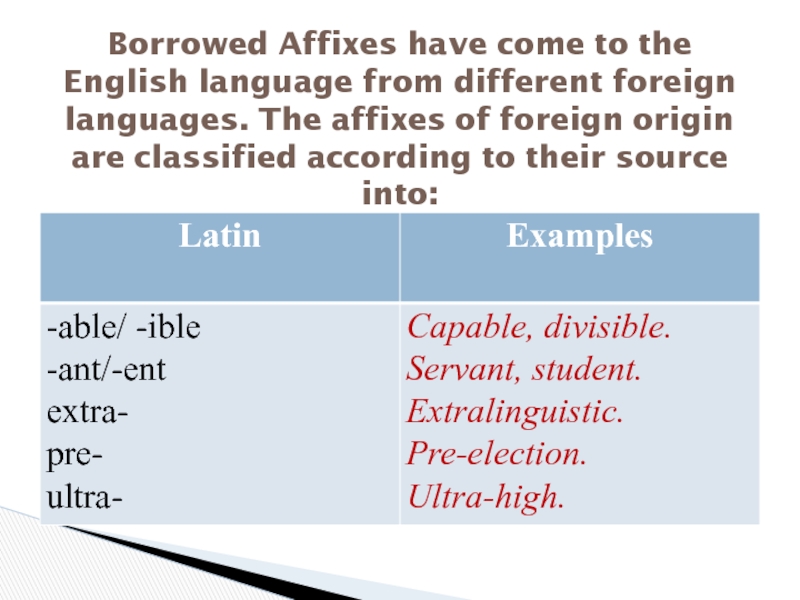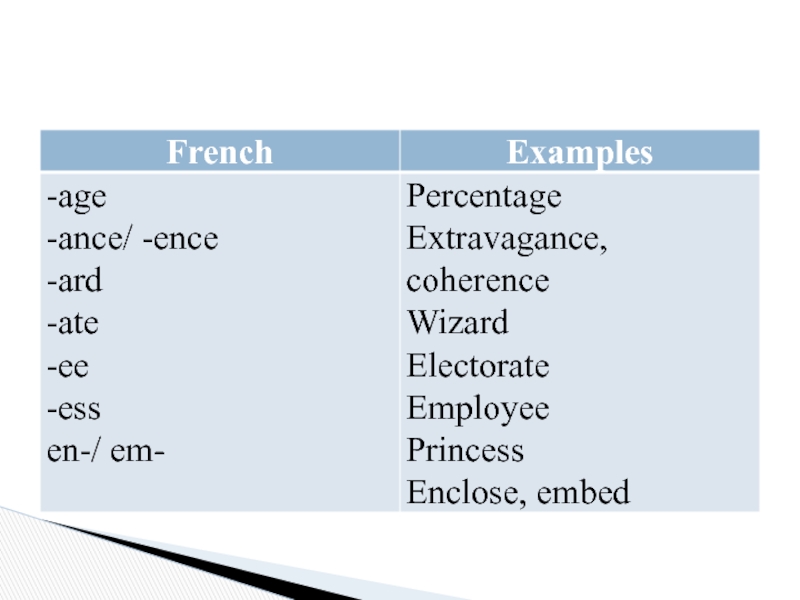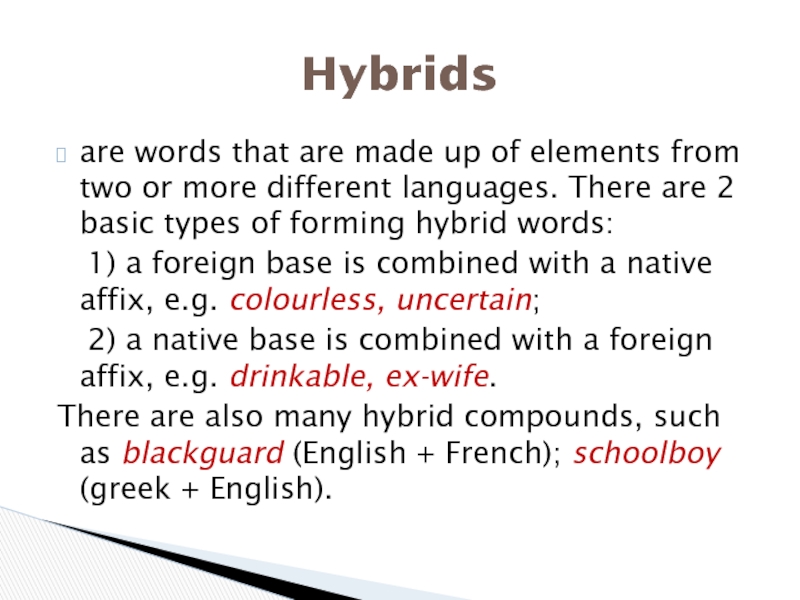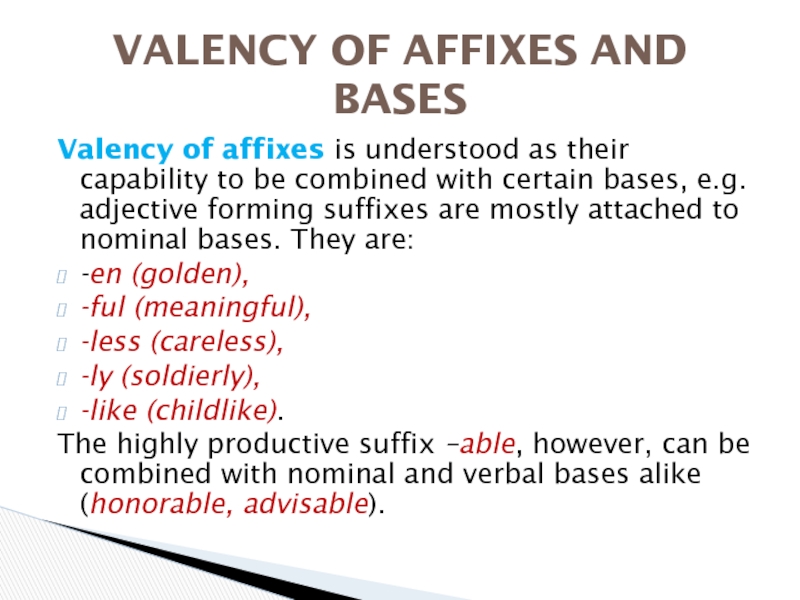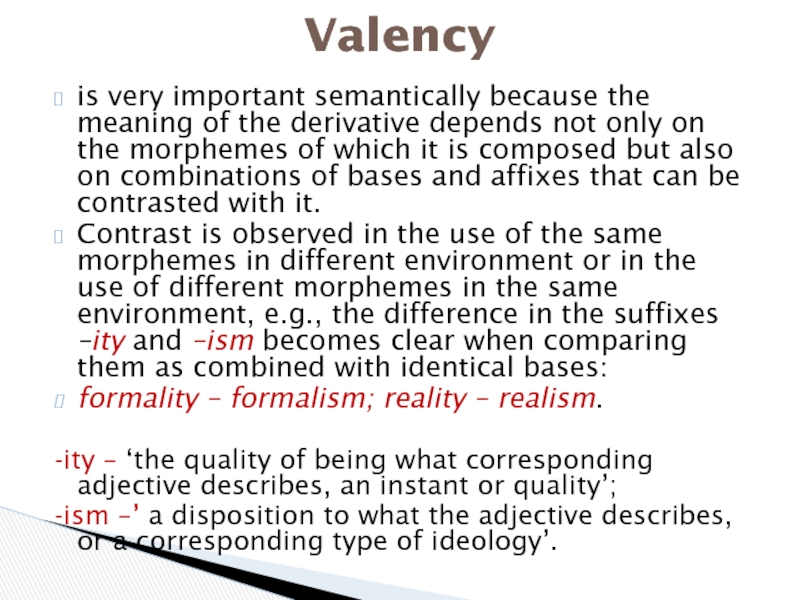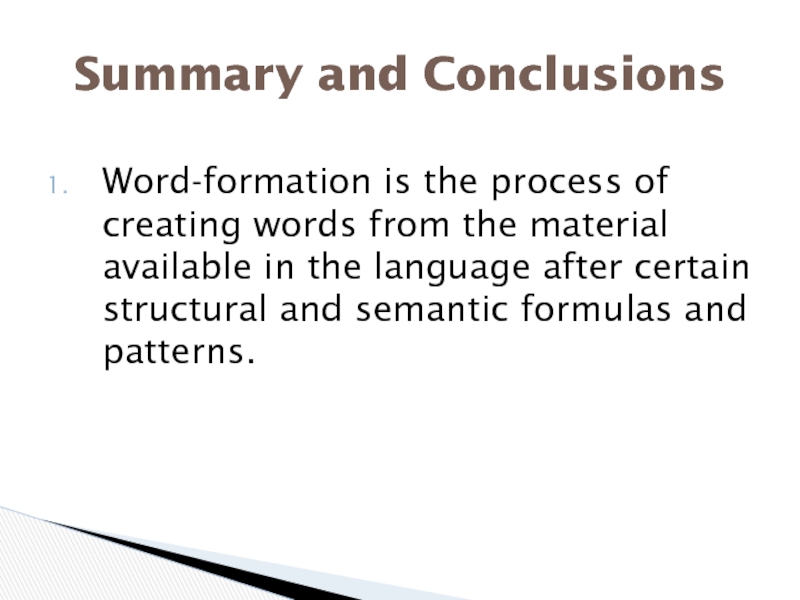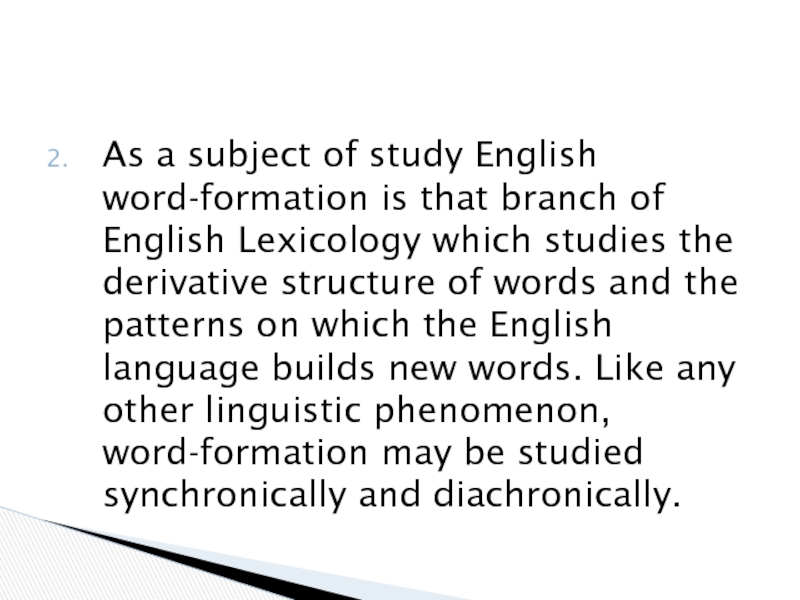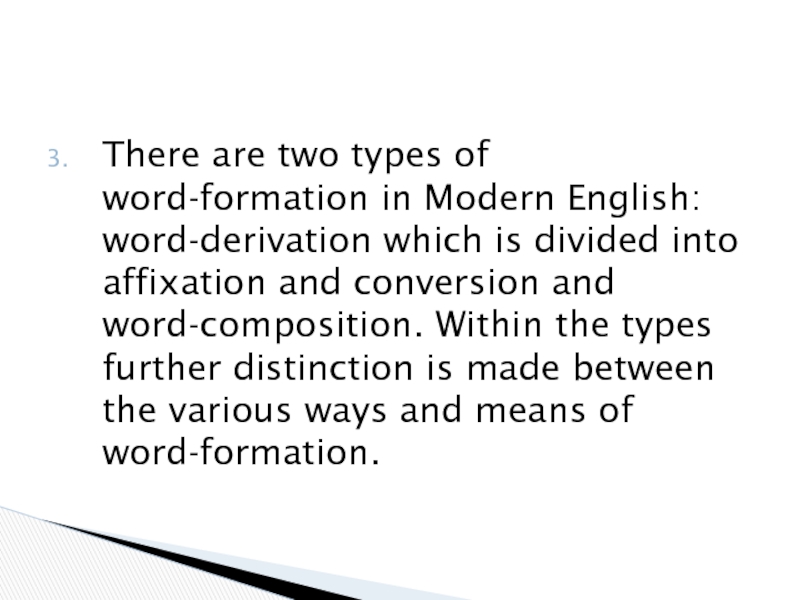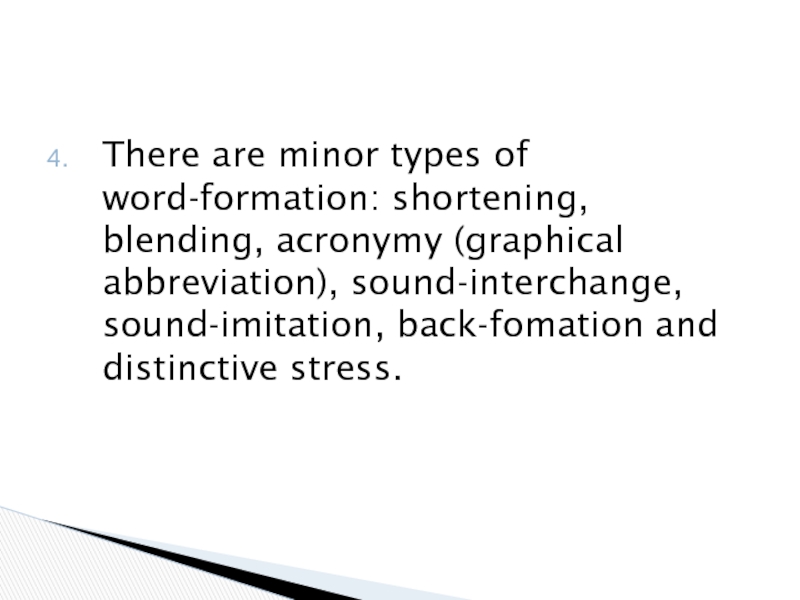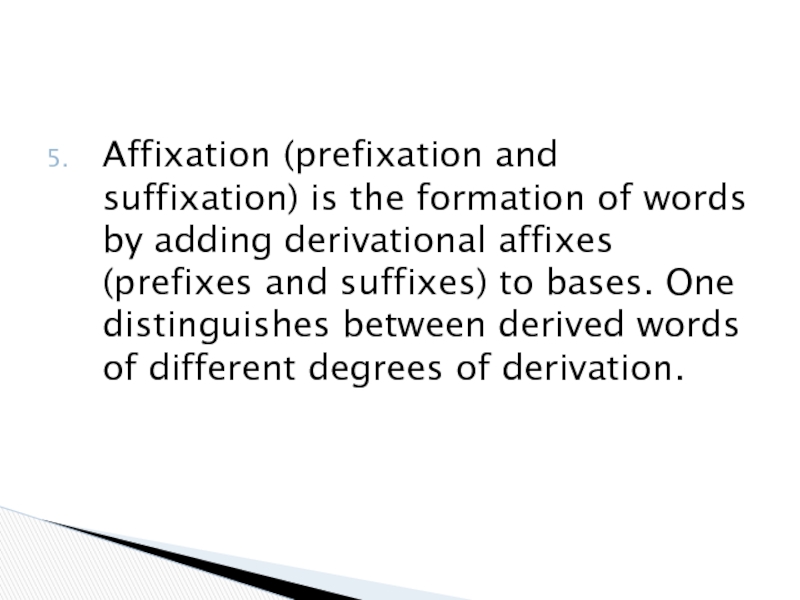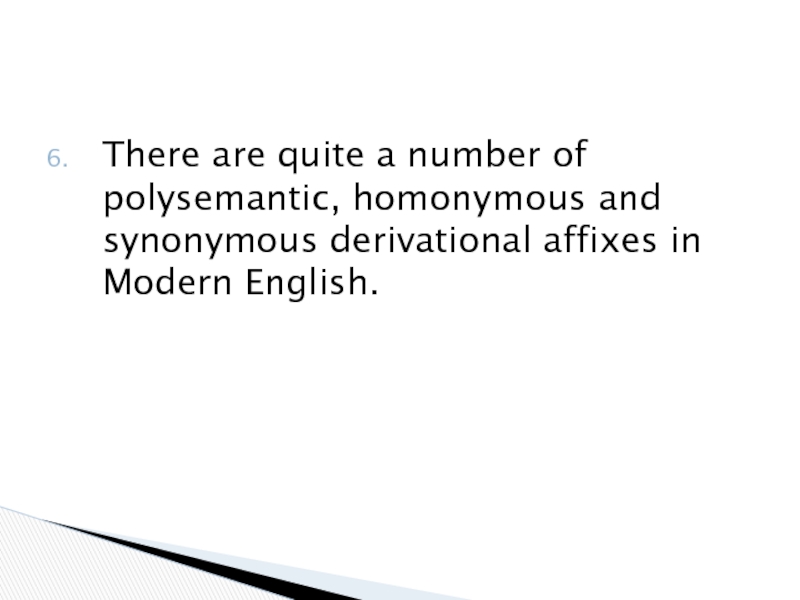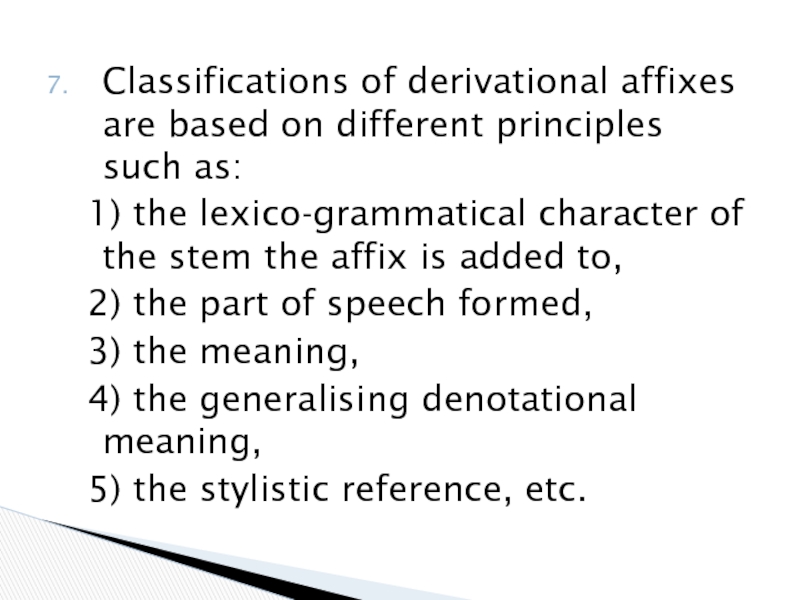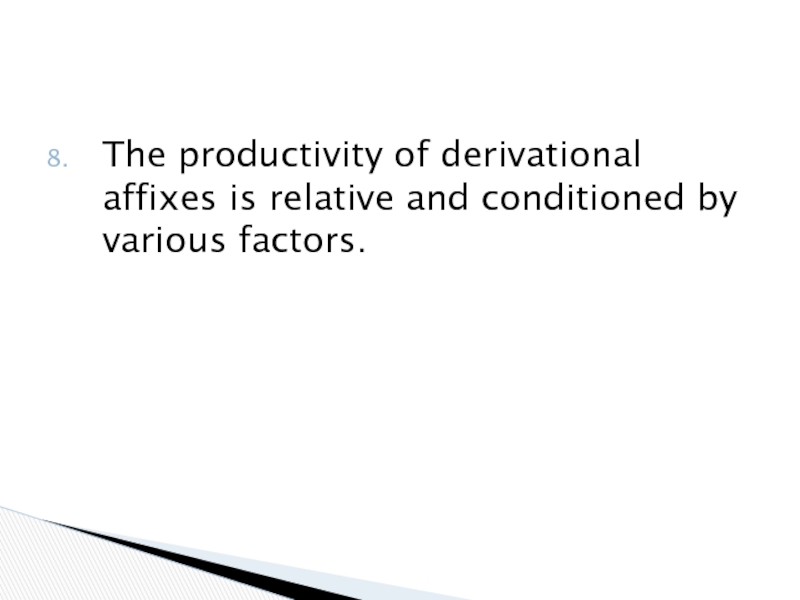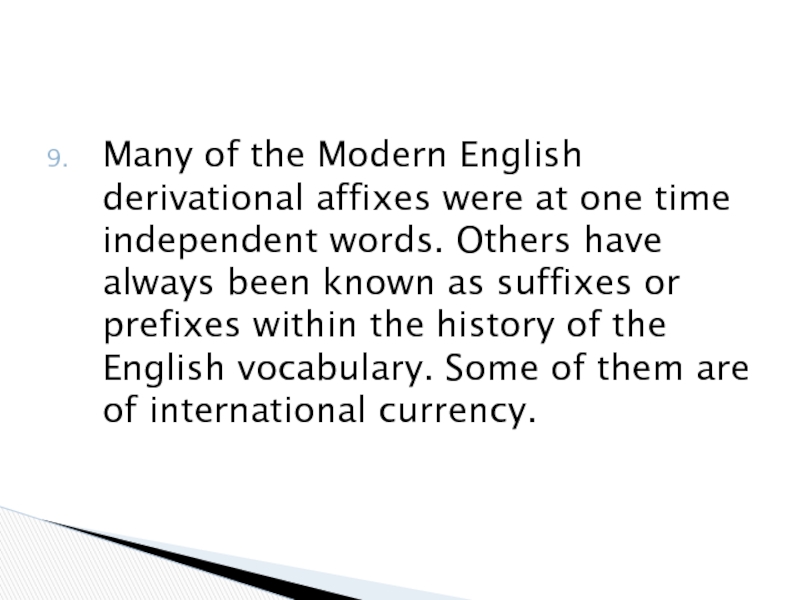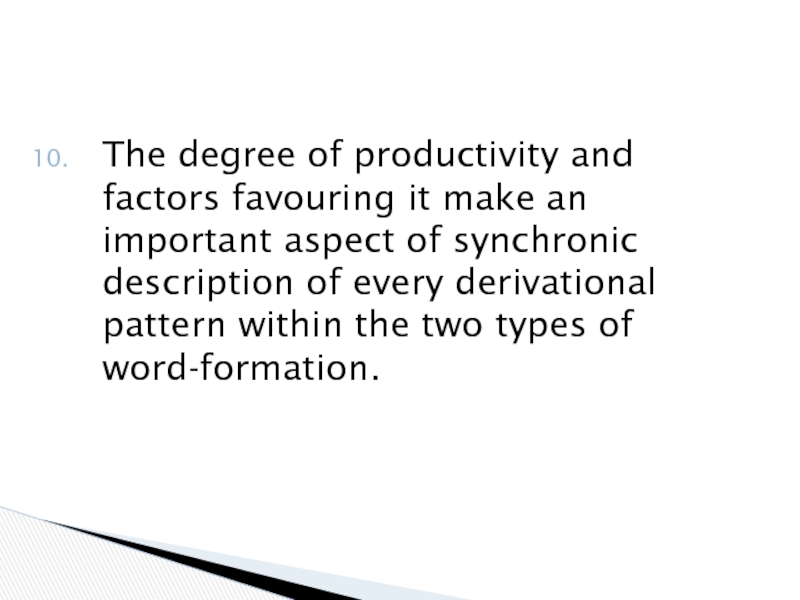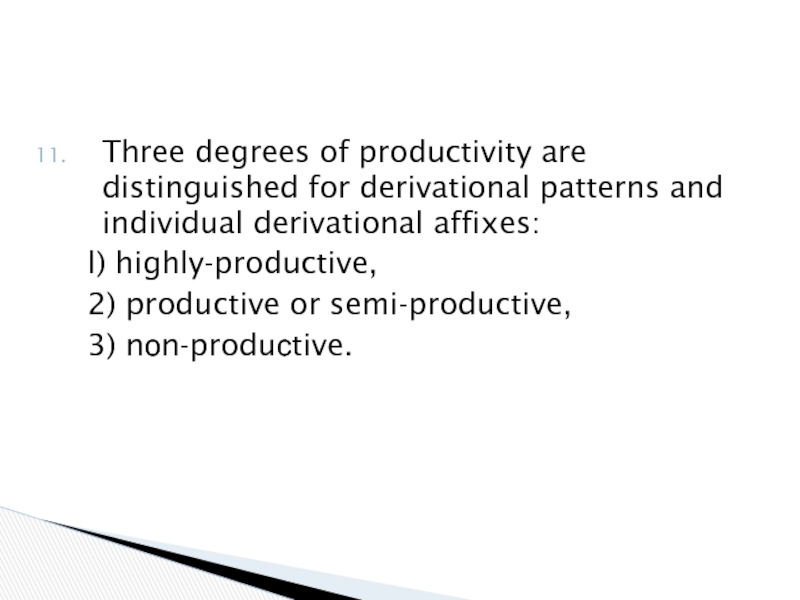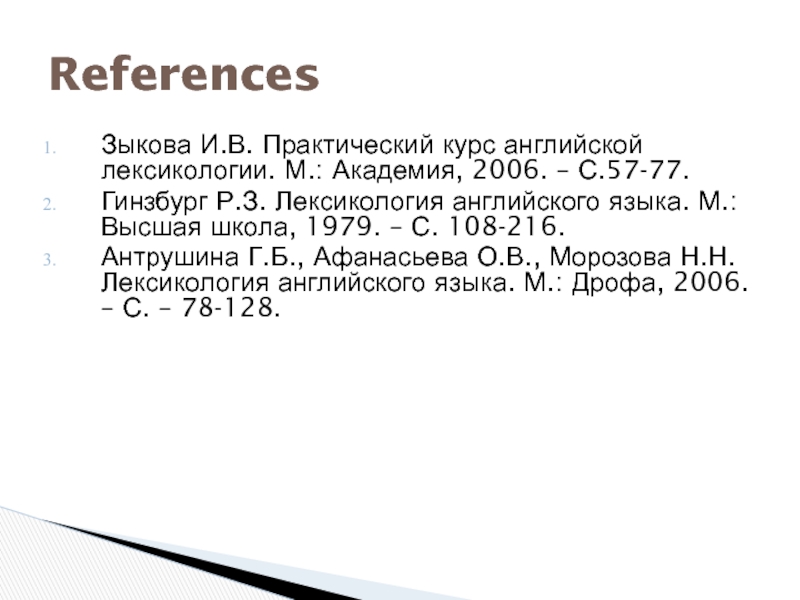- Главная
- Разное
- Дизайн
- Бизнес и предпринимательство
- Аналитика
- Образование
- Развлечения
- Красота и здоровье
- Финансы
- Государство
- Путешествия
- Спорт
- Недвижимость
- Армия
- Графика
- Культурология
- Еда и кулинария
- Лингвистика
- Английский язык
- Астрономия
- Алгебра
- Биология
- География
- Детские презентации
- Информатика
- История
- Литература
- Маркетинг
- Математика
- Медицина
- Менеджмент
- Музыка
- МХК
- Немецкий язык
- ОБЖ
- Обществознание
- Окружающий мир
- Педагогика
- Русский язык
- Технология
- Физика
- Философия
- Химия
- Шаблоны, картинки для презентаций
- Экология
- Экономика
- Юриспруденция
Types of Forming Words. Affixation презентация
Содержание
- 1. Types of Forming Words. Affixation
- 2. Word-formation is the system of derivational types
- 3. I. Word-derivation in morphology is a word-formation
- 4. shortening is the formation of a word
- 5. blending is the formation of a new
- 6. sound-interchange is the formation of a word
- 7. sound imitation (or onomatopoeia) is the naming
- 8. back-formation is the formation of a new
- 9. is that branch of Lexicology which studies
- 10. Synchronically – investigation of the existing system
- 11. In the history of the English language
- 12. Affixation is the formation of words by
- 13. Zero - degree of derivation is ascribed
- 14. Distinction is naturally made between prefixal and
- 15. Affixation is subdivided into suffixation and prefixation.
- 16. reappearance, unreasonable, denationalise This qualification is relevant
- 17. Suffixation is mostly characteristic of noun and
- 18. Suffixes as a rule function in any
- 19. Suffixation is the formation of words with
- 20. According to the lexical-grammatical character of the
- 21. According to the part of speech formed
- 22. Semantically suffixes fall into: Monosemantic:the suffix -ess
- 23. According to their generalizing denotational meaning suffixes
- 24. According to their stylistic reference suffixes may
- 25. Prefixation is the formation of words with
- 26. According to the lexico-grammatical character of the
- 27. According to the class of words they
- 28. Semantically prefixes fall into: Monosemantic: the prefix
- 29. According to their generalizing denotational meaning prefixes
- 30. According to their stylistic reference prefixes fall
- 31. The word-forming activity of affixes may change
- 32. Some productive affixes
- 33. Some non-productive suffixes:
- 34. The productivity of an affix should not
- 35. Native affixes are those in the Old
- 36. Origin of Derivational Affixes
- 37. Adjective-forming affixes:
- 39. Borrowed Affixes have come to the English
- 42. are words that are made up of
- 43. Valency of affixes is understood as their
- 44. is the possibility of a particular base
- 45. is very important semantically because the meaning
- 46. Word-formation is the process of creating words
- 47. As a subject of study English word-formation
- 48. There are two types of word-formation in
- 49. There are minor types of word-formation: shortening,
- 50. Affixation (prefixation and suffixation) is the formation
- 51. There are quite a number of polysemantic,
- 52. Classifications of derivational affixes are based on
- 53. The productivity of derivational affixes is relative and conditioned by various factors.
- 54. Many of the Modern English derivational affixes
- 55. The degree of productivity and factors favouring
- 56. Three degrees of productivity are distinguished for
- 57. Зыкова И.В. Практический курс английской лексикологии. М.:
Слайд 2Word-formation is the system of derivational types of words and the
Driver = v+-er (a verbal stem + the noun-forming suffix –er).
The meaning of the derived noun driver - the meaning of the stem drive- ‘to direct the course of a vehicle’ and the suffix -er meaning ‘an active agent’: a driver is ‘one who drives’ (a carriage, motorcar, railway engine, etc.).
1. TYPES OF FORMING WORDS
Слайд 3I. Word-derivation in morphology is a word-formation process by which a
The basic ways of forming words in word-derivation are:
1. Affixation is the formation of a new word with the help of affixes: pointless (from point).
2. Conversion is the formation of a new word by bringing a stem of this word into a different formal paradigm: a fall (from to fall), a cut (from to cut).
II. Word-composition is the formation of a new word by combining two or more stems which occur in the language as free forms: door-bell, house-keeper.
1.1. Main Types of Forming Words
Слайд 4shortening is the formation of a word by cutting off a
a) initial (or aphesis):fend (v) < defend, phone < telephone;
b) medial (orsyncope): specs < spectacles, fancy < fantasy;
c) final (or apocope): lab – laboratory, exam – examination;
d) both initial and final: flu < influenza, fridge < refrigerator;.
1.2. Minor Types of Forming Words
Слайд 5blending is the formation of a new word by combining parts
a) additive type: smog – sm(oke) and (f)og; b) restrictive type: telecast – television + broadcast.
acronymy (or graphical abbreviation) is the formation of a word from the initial letters of a word combination. :
a) acronyms which are read as ordinary English words:UNESCO – [ju:'neskəu] the United Nations Educational Scientific and Cultural Organization;
b) acronyms with the alphabetic reading: BBC – [,bi:bi:'si:] the British Broadcasting Corporation;
Слайд 6sound-interchange is the formation of a word due to an alteration
a) vowel-interchange (or ablaut): full − to fill, blood − to bleed, food – to feed. In some cases vowel-interchange is combined with suffixation: long − length, strong − strength, broad − breadth;
b) consonant-interchange: advice – to advise.
c) combined forms: life – to live;
Particular cases of sound-interchange:
[k] — [t∫]: to speak — speech,
[s] — [d]: defence — to defend; offence — to offend;
[s] — [t]: evidence — evident, importance — important, etc.
Слайд 7sound imitation (or onomatopoeia) is the naming of an action or
Groups:
a) words denoting sounds produced by human being in the process of communication or expressing their feelings: mumble, babble;
b) words denoting sounds produced by animals, birds, insects: mew, croak, buzz;
c) words imitation the sound of water, the noise of metallic things, a forceful motion, movement: splash, clink, bang.
Слайд 8back-formation is the formation of a new word by subtracting a
distinctive stress is the formation of a new word by means of the shift of the stress in the source word, cf.: export (n) — to ex´port; ´import (n) — to im´port; ‘
Слайд 9is that branch of Lexicology which studies the derivative structure of
Word-formation can deal only with words which are analysable both structurally and semantically, i.e. with all types of Complexes.
2. Word-formation as the Subject of Study
Слайд 10Synchronically – investigation of the existing system of the types of
Diachronically – chronological order of formation of one word from some other word that is relevant.
Word-formation may be studied:
Слайд 11In the history of the English language there are cases when
back-formation (or back-derivation) :
cf. beggar — to beg; editor — to edit; chauffeur — to chauff
The fact that historically the verbs
to beg, to edit, etc. were derived from the corresponding agent-nouns is of no synchronous relevance.
Слайд 12Affixation is the formation of words by adding derivational affixes to
An affix is not-root or a bound morpheme that modifies the meaning and / or syntactic category of the stem in some way.
Affixes are classified into prefixes and suffixes.
3. AFFIXATION
Слайд 13Zero - degree of derivation is ascribed to simple words, i.e.
First - derived words whose bases are built on simple stems and thus are formed by the application of one derivational affix, e.g. atomic, hasty, devotion, etc.
Second - derived words formed by two consecutive stages of coining, e.g. atomical, hastily, devotional, etc.
Degrees of Derivation
Слайд 14Distinction is naturally made between prefixal and suffixal derivatives according to
unjust (un-+just),
justify, (just++ -ify),
arrangement (arrange + -ment),
non-smoker (non- + smoker).
Affixation=suffixation+prefixation
Слайд 15Affixation is subdivided into suffixation and prefixation.
Distinction is naturally made
unjust (un-+just),
justify, (just++ -ify),
arrangement (arrange + -ment),
non-smoker (non- + smoker).
Слайд 16reappearance, unreasonable, denationalise
This qualification is relevant only in terms of the
From the point of view of derivational analysis such words are mostly either suffixal or prefixal derivatives, e.g.
sub-atomic = sub- + (atom + + -ic), unreasonable = un- + (reason + -able), denationalise = de- + + (national + -ize), discouragement = (dis- + courage) + -ment.
Prefixal-suffixal derivatives:
Слайд 17Suffixation is mostly characteristic of noun and adjective formation.
Prefixation is mostly
The distinction also rests on the role different types of meaning play in the semantic structure of the suffix and the prefix.
The part-of-speech meaning has a much greater significance in suffixes as compared to prefixes which possess it in a lesser degree.
A prefix may be confined to one part of speech, e.g. enslave, encage, unbutton or may function in more than one part of speech as, e.g., over- in overkind a, to overfeed v, overestimation n
Слайд 18Suffixes as a rule function in any one part of speech
A suffix closely knit together with a base forms a fusion retaining less of its independence than a prefix which is as a general rule more independent semantically, cf. reading — ‘the act of one who reads’; ‘ability to read’; and to re-read — ‘to read again.'
Слайд 19Suffixation is the formation of words with the help of suffixes,
Some suffixes do not shift words from one part of speech into another, but usually transfer a word into a different semantic group, e.g. a concrete noun becomes an abstract one, e.g. child — childhood, friend — friendship, etc.
A suffix is a derivational morpheme following the root and forming a new derivative in a different word class (-en, -y, -less in heart-en, heart-y, heart-less).
3.1. SUFFIXATION.
CLASSIFICATION OF SUFFIXES
Слайд 20According to the lexical-grammatical character of the base suffixes are usually
deverbal suffixex (those added to the verbal base): -er (builder); -ing (writing);
denominal suffixes (those added to the nominal base): -less (timeless); -ful (hopeful); -ist (scientist); -some (troublesome);
deajectival suffixes (those added to the adjectival base): -en (widen); -ly (friendly); -ish (whitish); -ness (brightness).
Suffixes can be classified into different types in accordance with different principles:
Слайд 21According to the part of speech formed suffixes fall into several
noun-forming suffixes: -age (breakage, bondage); -ance/-ence (assistance, reference); -dom (freedom, kingdom); -er (teacher, baker); -ess (actress, hostess); -ing (building, wasing);
adjective-forming suffixes: -able/-ible/-uble (favourable, incredible, soluble); -al (formal, official); -ic (dynamic); -ant/-ent (repentant, dependent);
numeral-forming suffixes: -fold (twofold); -teen (fourteen); -th (sixth); -ty (thirty);
verb-forming suffixes: -ate (activate); -er (glimmer); -fy/-ify (terrify, specify); -ize (minimize); -ish (establish);
adverb-forming suffixes: -ly (quickly, coldly); -ward/-wards (backward, northwards); -wise (likewise).
Слайд 22Semantically suffixes fall into:
Monosemantic:the suffix -ess has only one meaning ‘female’
Polysemantic: the suffix -hood has two meanings:
‘condition or quality’ – falsehood, womanhood;
‘collection or group’ – brotherhood.
Слайд 23According to their generalizing denotational meaning suffixes may fall into several
the agent of the action: -er (baker); -ant (accountant);
appurtenance: -an/-ian (Victorian, Russian); -ese (Chinese);
collectivity: -dom (officialdom); -ry (pleasantry);
Diminutiveness:-ie (birdie); -let (cloudlet); -ling (wolfling).
Слайд 24According to their stylistic reference suffixes may be classified into:
those characterized
those having a certain stylistic value: -oid (asteroid); -tron (cyclotron).
These suffixes occur usually in terms and are bookish.
Слайд 25Prefixation is the formation of words with the help of prefixes,
A prefix is a derivational morpheme preceding the root-morpheme and modifying its meaning (understand – mis-understand, correct – in-correct).
3.2. PREFIXATION.
CLASSIFICATION OF PREFIXES.
Слайд 26According to the lexico-grammatical character of the base prefixes are usually
deverbal (those added to the verbal base): re- (rewrite); over- (overdo); out- (outstay);
denominal (those added to the nominal base): - (unbutton); de- (detrain); ex- (ex-president);
deadjectival (those added to the adjectival base): un- (uneasy); bi- (biannual).
deadverbial (those added to the adverbial base): un- (unfortunately); in- independently).
Prefixes can be classified according to different principles.
Слайд 27According to the class of words they preferably form prefixes are
verb-forming prefixes: en-/em- (enclose, embed); be- (befriend); de- (dethrone);
noun-forming prefixes: non- (non-smoker); sub- (sub-committee); ex- (ex-husband)
adjective-forming prefixes: un- (unfair); il- (illiterate); ir- (irregular);
adverb-forming prefixes: un- (unfortunately); up- (uphill).
Слайд 28Semantically prefixes fall into:
Monosemantic: the prefix ex- has only one meaning
Polysemantic; the prefix dis- has four meanings:
‘not’ (disadvantage);
‘reversal or absence of an action or state’ (diseconomy, disaffirm);
‘removal of’ (to disbranch);
‘completeness or intensification of an unpleasant action’ (disgruntled).
Слайд 29According to their generalizing denotational meaning prefixes fall into:
negative prefixes: un-
reversative prefixes: un2- (untie); de- (decentralize); dis2- (disconnect);
pejorative prefixes: mis- (mispronounce); mal- (maltreat); pseudo- (pseudo-scientific);
prefixes of time and order: fore- (foretell); pre- (pre-war); post- (post-war), ex- (ex-president);
prefix of repetition: re- (rebuild, rewrite);
locative prefixes: super- (superstructure), sub- (subway), inter- (inter-continental), trans- (transatlantic).
Слайд 30According to their stylistic reference prefixes fall into:
those characterized by neutral
those possessing quite a definite stylistic value: pseudo- (pseudo-classical); super- (superstructure); ultra- (ultraviolet); uni- (unilateral); bi- (bifocal).
These prefixes are of a literary-bookish character.
Слайд 31The word-forming activity of affixes may change in the course of
Thus, productive affixes are those used to form new words in this particular period of language development.
4. PRODUCTIVE AND NON-PRODUCTIVE AFFIXES
Слайд 34The productivity of an affix should not be confused with its
An affix may occur in hundreds of words, but if it is not used to form new words, it is not productive, for instance, the adjective suffix –ful.
Слайд 35Native affixes are those in the Old English period or were
The change a morpheme undergoes in the course of time may be of different kinds.
A bound morpheme, e.g. may be developed from a free one. Such are the suffixes
– dom (‘fate, power’);
hood ‘state’;
-lock ‘actions or proceedings, practice’;
-ship ‘state, conduct’, and the prefixes;
over- ‘in excess, extra, upper’;
out- ‘foreign, external’, ect.
Etymology of Derivational Affixes:
Слайд 39Borrowed Affixes have come to the English language from different foreign
Слайд 42are words that are made up of elements from two or
1) a foreign base is combined with a native affix, e.g. colourless, uncertain;
2) a native base is combined with a foreign affix, e.g. drinkable, ex-wife.
There are also many hybrid compounds, such as blackguard (English + French); schoolboy (greek + English).
Hybrids
Слайд 43Valency of affixes is understood as their capability to be combined
-en (golden),
-ful (meaningful),
-less (careless),
-ly (soldierly),
-like (childlike).
The highly productive suffix –able, however, can be combined with nominal and verbal bases alike (honorable, advisable).
VALENCY OF AFFIXES AND BASES
Слайд 44is the possibility of a particular base to take a particular
the noun-forming suffixes, e.g. –eer (profiteer), -ful (spoonful), -ics (linguistics), -let (cloudlet);
the adjective-forming suffixes, e.g. –al (doctoral), -ary (revolutionary), -ous (spacious), -ic (historic);
the verb-forming suffixes, e.g. –en (hearten), -ize (sympathize).
Valency of bases
Слайд 45is very important semantically because the meaning of the derivative depends
Contrast is observed in the use of the same morphemes in different environment or in the use of different morphemes in the same environment, e.g., the difference in the suffixes –ity and –ism becomes clear when comparing them as combined with identical bases:
formality – formalism; reality – realism.
-ity – ‘the quality of being what corresponding adjective describes, an instant or quality’;
-ism –’ a disposition to what the adjective describes, or a corresponding type of ideology’.
Valency
Слайд 46Word-formation is the process of creating words from the material available
Summary and Conclusions
Слайд 47As a subject of study English word-formation is that branch of
Слайд 48There are two types of word-formation in Modern English: word-derivation which
Слайд 49There are minor types of word-formation: shortening, blending, acronymy (graphical abbreviation),
Слайд 50Affixation (prefixation and suffixation) is the formation of words by adding
Слайд 51There are quite a number of polysemantic, homonymous and synonymous derivational
Слайд 52Classifications of derivational affixes are based on different principles such as:
1) the lexico-grammatical character of the stem the affix is added to,
2) the part of speech formed,
3) the meaning,
4) the generalising denotational meaning,
5) the stylistic reference, etc.
Слайд 54Many of the Modern English derivational affixes were at one time
Слайд 55The degree of productivity and factors favouring it make an important
Слайд 56Three degrees of productivity are distinguished for derivational patterns and individual
l) highly-productive,
2) productive or semi-productive,
3) nоn-produсtive.
Слайд 57Зыкова И.В. Практический курс английской лексикологии. М.: Академия, 2006. – С.57-77.
Гинзбург Р.З. Лексикология английского языка. М.: Высшая школа, 1979. – С. 108-216.
Антрушина Г.Б., Афанасьева О.В., Морозова Н.Н. Лексикология английского языка. М.: Дрофа, 2006. – С. – 78-128.
References
